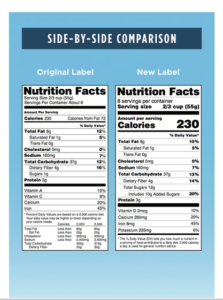Food Labeling FAQ
Q: Can I call my product GLUTEN FREE?
A: The FDA published the final rule for a GLUTEN FREE labeling claim on August 5, 2013, and it became effective on September 4, 2013. The compliance date for the rule is August 5, 2014. Under the FDA rule, if a food carries a gluten free claim, it either: Inherently does not contain gluten ( e.g. a bag of raw apples or bottled water)
-OR-
Meets the following criteria:
* Does NOT contain an ingredient that is a whole, gluten-containing grain ( i.e. wheat, barley, rye, and crossbred hybrids of these grains)
* Does NOT contain an ingredient that is derived from a gluten-containing grain and has NOT been processed to remove gluten (e.g., what flour)
* May contain an ingredient that is derived from a gluten-containing grain and has been processed to remove gluten (e.g. wheat starch) as long as the food product contains less than 20 ppm gluten.
-AND-
* Any avoidable gluten in the food due to cross-contact in the production area or migration of gluten from packaging materials is less than 20 ppm gluten
For more information: http://www.fda.gov/Food/GuidanceRegulation/GuidanceDocumentsRegulatoryInformation/Allergens/ucm362880.htm
Q: How is trans fat listed on the Nutrition Facts Panel?
A: The FDA published the final rule on July 11, 2003, and states that any conventional food or dietary supplement that is produced and shipped in interstate commerce after January 1, 2006 must comply with the labeling requirements for trans fat:
Any product that has left the manufacturers possession and is part of another firm’s inventory (distributor) prior to January 1, 2006 may be distributed and sold after this date (as long as they do not enter interstate commerce). There is no deadline by which these products need to be sold. However, products previously labeled without trans fat and in the manufacturer’s possession cannot enter interstate commerce on or after January 1, 2006.
Trans fatty acids should be listed as “Trans Fat” or “Trans” on a separate line under the listing of saturated fat in the Nutrition Facts Label. Trans fat content must be expressed as grams per serving to the nearest 0.5-gram increment below 5 grams and to the nearest gram above 5 grams. If a serving contains less than 0.5 gram, the content, when declared, must be expressed as “0”.
If a product qualifies for a “simplified” Nutrition Facts Panel, has a “0” value for total fat, and there are no nutrient claims made about trans fat, total fat, saturated fat, or cholesterol, trans fat does not need to be declared. In the absence of these claims, the statement “Not a significant source of trans fat” may be placed at the bottom of the table of nutrient values in lieu of declaring “0g” of trans fat.
Q: How should I list potential allergens on my product label?
A: There are eight major food allergens that can cause potentially life- threatening allergic reactions in consumers: milk, soybean, tree nuts, peanuts, eggs, wheat, fish and shellfish.
To provide more customer-friendly food labels, Congress passed the Food Allergen Labeling and Consumer Protection Act (FALCPA) in August of 2004. This law went into effect on January 1, 2006, therefore, any food label that is applied to a food product during production on or after this date must be in compliance.
There are two ways to provide the required allergy information on your food label:
1. The ingredient statement will state the allergen in common terms as part of its name (i.e.: “casein (milk)”, “TVP (soy)”.)
2. There will be an allergen summary statement directly after the ingredient list that clearly states the potential allergen that is present in the product:
“Contains __________________________” *
(Examples of acceptable ingredient terms commonly understood by consumers of major food allergens include: “eggs”, “milk”, “peanuts”, “shrimp”, “soy”, “walnut”, and “wheat”.)
*This statement must include any and all of the allergens from the ingredient list if used.
Q: I heard there are new FDA regulations for nutrition labels – what’s the scoop?
A: In 2016, the FDA finalized the new Nutrition Facts Panels for packaged foods to reflect new scientific information, including the link between diet and chronic diseases such as obesity and heart disease. The new label will also make it easier for consumers to make better informed food choices. Here are some of the highlights you may notice right away:
* A refreshed design including a larger type size for “Calories”, “servings per container”, and the “serving size” declaration, which is also now in bold along with the number of calories.
* Food manufacturers must now declare the actual amount, in addition to the percent Daily Value (%DV), of vitamin D, calcium, iron, and potassium. Vitamins A and C are no longer required, but can be included on a voluntary basis.
* “Added sugars” in grams and as a % Daily Value must now be included on the label. Added sugar is defined as common ingredients such as granulated beet or cane sugar, maple syrup, corn syrup, honey, and concentrated fruit. The 2015-2020 Dietary Guidelines for Americans recommends that no more than 15% of your total daily calories from added sugar.
* “Calories from Fat” is no longer required because nutrition research shows that the type of fat is more important than the amount.
For more information, see:
Industry Resources on the Changes to the Nutrition Facts Label
https://www.fda.gov/food/food-labeling-nutrition/industry-resources-changes-nutrition-facts-label
Q: When do my products need to have the new Nutrition Facts Panel?
A: It depends on the size of your company’s annual food sales:
less than $10 million – January 1, 2021
equal to or more than $10 million – January 1, 2020
